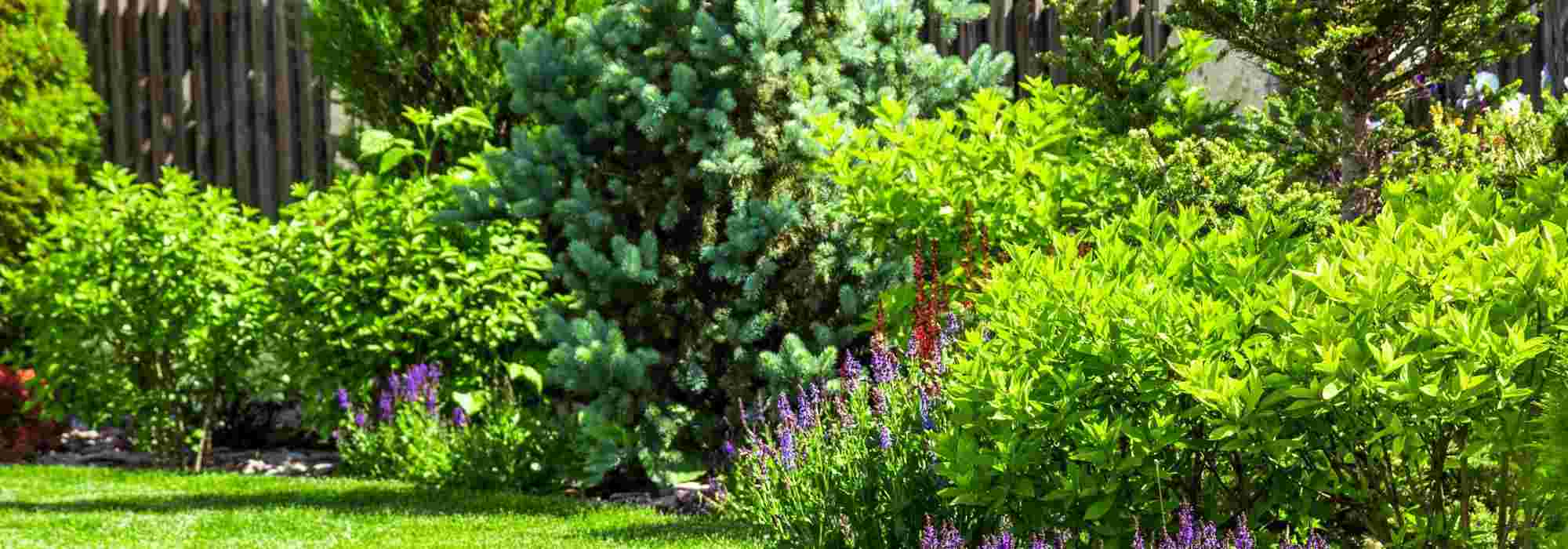
Garden in a housing estate: how to lay out and personalise?
Ideas and tips
Contents
Small, ordinary, overlooked by neighbours… Housing estate gardens can seem difficult to lay out. All these constraints also provide a framework for creating a true green haven. Admittedly, they are small, but will require less maintenance. Their shape, which may seem too conventional, is actually very practical to lay out. A rectangular base leaves room to play with geometric shapes. As for being overlooked, it is always possible to get round it. There are many ways to set your housing estate garden apart and design it to reflect your style!
Make it look bigger
Housing estate gardens are not known for being spacious. That said, there are many techniques to hide this minor flaw and make it feel much bigger! The first technique is to make its boundaries disappear. If you cannot see the end of a garden, you will tend to imagine it as more extensive. If it has walls or fences, hide them with planting. Some bamboos or a few young plants of Miscanthus Giganteus will soon take care of the job. If you opt for bamboos, choose them carefully or arrange installation of an anti-rootstock barrier so they do not become invasive. Another trick is to leave part of a wall visible at the far end of the garden and install a door in it. Although it leads nowhere, that door suggests there is more to the visit.
→ read: “Which type of bamboo to choose? Our advice”
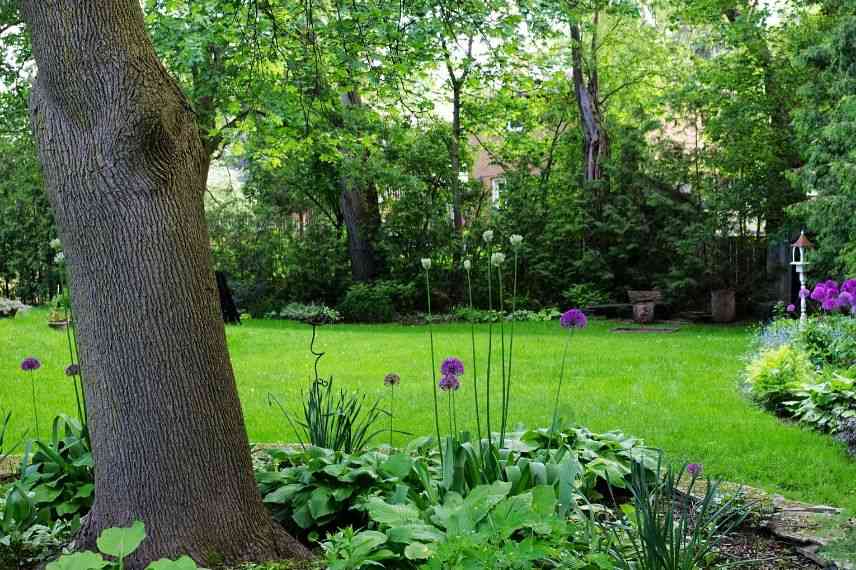
Try to hide the boundaries of the plot with vegetation
Read also
7 trees for small gardensAdd colour to a wall
A coloured wall, if your housing estate regulations allow it, has several advantages. On the one hand, it highlights plants. An orange, red, blue or pink wall will bring out the green of the leaves and enhance the flowers. Play with complementary colours! With a blue wall, opt for orange flowering such as that of the Achillée millefolium ‘Terracotta’. Conversely, a wall in red tones will showcase the ceanothus’s evergreen foliage and its blue flowers. Moreover, in a housing estate where all the gardens look the same, you’ll have a touch of originality! Your garden will resemble no other. Final advantage: it creates the impression that the garden is larger. Indeed, a coloured wall, especially at the back of the garden, creates a sense of depth.
A terrace, a true living space
The terrace beside the house is a must! Whether wood, stone, paving slabs or concrete, it defines a first room of the garden on its own. It’s a place where you will spend a lot of time, with family or friends. So it’s important to go all out in this part of the garden. To do that, plant borders around it! They will surround it and connect it to the rest of the garden. Opt for staggered flowering: cyclamen flowers brighten early spring, followed by the little pink pom-poms of Aethionema. In summer, Acanthus, Aconitum and astilbes, to name but a few, take centre stage. In autumn, play with foliage, such as that of Nandina domestica, which turns purple. Once winter comes, the garden is far from dead! Cornus sanguinea, which has lovely leaves in summer, gives way to red/orange shoots that catch the eye during the cool season. For a finishing touch to the terrace, a shade sail! It protects from the blazing sun in summer and gives the garden a modern edge.
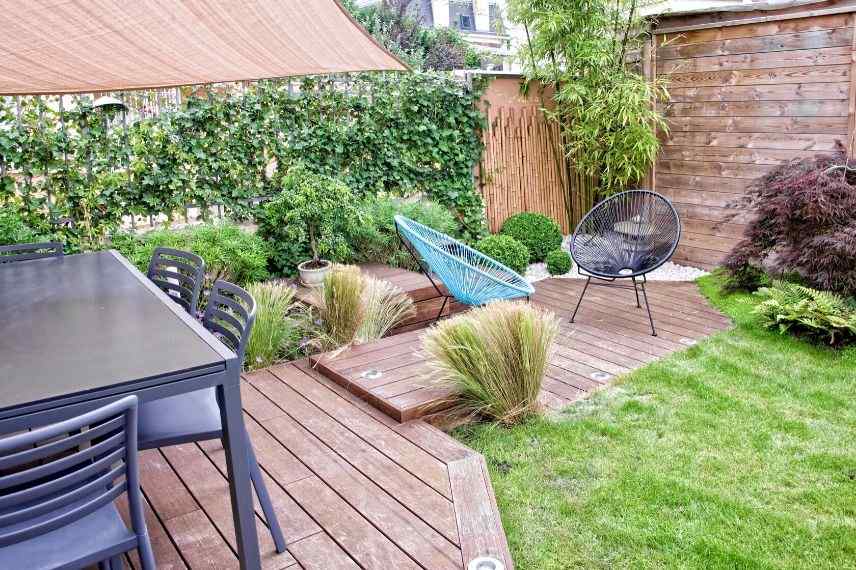
The terrace is a real living space!
Read also
Designing a small gardenCreate multiple spaces
Housing estate gardens are small, admittedly. But they have the advantage of being easy to structure. Laying out several zones lets you make the most of your outdoor space and exploit its full potential. You can then separate the dining area from the lounge area, add beds to create your green retreat, and why not include a space for children. Once the patio is laid out, you can focus on the rest of the garden. Why not create a small reading nook at the back of the garden? Plant a few bushes around, such as an Aralia and a Cotinus coggygria, then place an armchair in the middle for a bit of privacy. You could also create a second, smaller patio with a few paving slabs or some wood slats. Comfortable layers, a bed of perennials and a fountain will bring you a little serenity. Then, set aside a space for children! Install a wooden playhouse, an igloo or a tipi. This new world will let them play outside all day and create imaginary worlds.
Connect and organise
All these living spaces must be easily accessible. For this, opt for paths! To liven up a rather traditional estate garden layout, you can create curved or diagonal lines. To connect terrace to children’s area, a wide path links and divides garden into two parts. Many options are available. An authentically styled option with stone slabs, a more natural look with a small wooden footbridge, or a very contemporary appearance with a concrete path lined with water channels. You are spoilt for choice! To structure spaces and achieve neat finishes, you can also install edging for beds, paths or terraces: aluminium or corten steel slats, small wooden logs, pebbles… Again, there’s no shortage of materials.
A garden without trees… or almost!
In a small garden, planting a tree is not always appropriate! Indeed, if planted too close to the house, it may damage foundations with its roots. Too close to neighbours, it may cause nuisance. You will then be forced to prune it severely, which is not recommended for a healthy specimen. So check the mature size of a specimen carefully before buying! It is not obligatory to plant trees. Tall grasses and bushes provide sufficient volume to create attractive plant densities at the back of borders. However, there are small trees suited to suburban gardens. This is the case with Japanese maples! Acer shirasawanum ‘Aureum’ reaches 4 m in height with a spread of 3 m. Preferring partial shade, its leaves turn golden in summer. Another attractive small tree: the shrimp willow! Cultivar Hakuro Nishiki grows to no more than 1.5 m and its crown forms a lovely globe. Over the seasons, its leaves change from salmon-pink to green, passing through white. Preferring partial shade, this small hardy willow has rapid growth.
→ Read: “7 trees perfect for small gardens” and “Planting trees and bushes: what does the law say? 8 questions and answers“
Small vegetable patch
You don’t have the space of a market gardener, and that’s a good thing! A large vegetable garden means a lot of work, so it’s better to be limited by space! A few rows of tomatoes, carrots, courgettes and potatoes are already a good start. Don’t hesitate to surround your vegetable garden with nasturtiums and marigolds. These pretty flowers repel pests and decorate the edge of the growing area. If you no longer have room on the ground, opt for raised vegetable beds. At waist height, they make work easier and can be placed on the patio. Consider hanging window boxes and filling them with herbs. They’ll then be within easy reach from the kitchen and won’t clutter the garden.
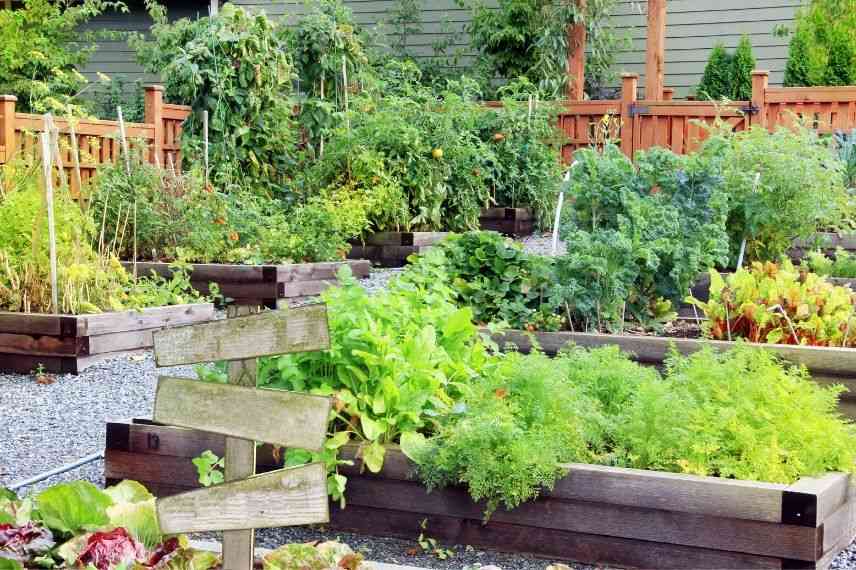
An example layout of a raised vegetable bed
→ Read: “Raised vegetable beds: why and how to build them?“
Playing with levels
Adds character to your outdoor space! Different levels break up the linear look of the housing estate to define distinct spaces. A raised terrace at the highest point can give way to a play area a little lower down. That way, you always have an eye on children while enjoying peace and quiet. To make the transition, planted slopes retained by low walls and a few steps.
Opt for lush, abundant borders
Borders will set the mood of the garden and create your little corner of paradise. They help blur garden boundaries when placed at the edges. Sometimes they separate spaces, for example terrace and pool. The denser they are, the more they screen prying eyes and create an intimate atmosphere. The lighter they are, the more they allow sightlines through. The idea is to place the tallest young plants at the back and the smallest at the front. Bushes and climbing plants such as star jasmine naturally find their place at the back. The medium of the border is planted with rather tall perennials, such as Gaura and medium-sized grasses like Astelia. In the foreground are smaller perennials, such as columbines and bleeding hearts. Borders require some maintenance: some pruning, watering and weeding. To reduce time spent caring for them, consider mulching; it slows growth of adventive plants, retains moisture in summer and warmth in winter. For an almost no-maintenance garden, plant groundcovers such as hardy geraniums. They require almost no maintenance, apart from restricting their spread.
Mistakes to avoid
Enough of Photinia hedges
Photinias are among hedging bushes used very commonly. Too common! Many gardens feature this species, whose glossy leaves change from green to red. It is an attractive bush when its natural habit is respected, but it is a victim of its own success and becomes too familiar, lacking elegance. To bring character and individuality to your garden, why not try a mixed hedge? You can mix flowering plants, small fruit trees and other melliferous bushes. Do not prune your hedge into rigid lines! Let the natural habit develop by carrying out only gentle pruning, so as to support growth of specimen without constraining it. For example, plant an amelanchier, with a rounded habit and beautiful white flowers in spring. Then add small fruit trees such as a dwarf peach or a dwarf cherry that do not exceed 2 m in height. Also opt for opulent flowering, such as a fine hydrangea or a snowball viburnum.
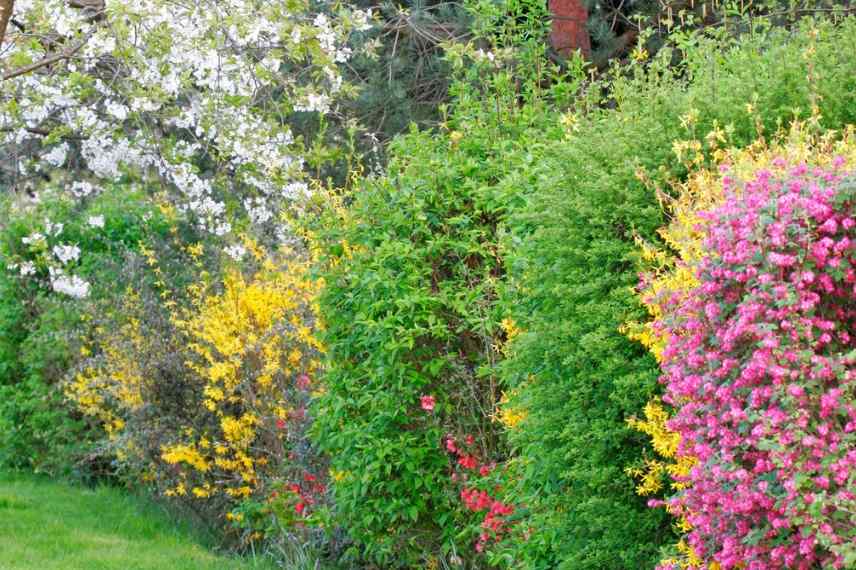
Flowering hedge in spring
Say no to trampolines
Besides being unattractive, it is dangerous for children. There are other ways for younger ones to have fun in garden while keeping it attractive. Why not build a den or buy a garden shelter? In wood, it will be discreet and become children’s hideout. You can also reserve a small patch of earth for them! Like a vegetable patch, they can experiment with ornamental or even vegetable plantings and have their own plant in garden. It is a good way to raise their awareness of gardening and give them a constructive activity. Strawberry plants are perfectly suited since children can savour fruit of their work. You can also incorporate a sandpit into layout. Long and narrow, it can help to delimit two garden areas!
Better too little than too much
Forget plastic Buddhas, white and black pebbles, garden gnomes and fake mushrooms! Adding a little decoration to garden can be very pretty, but a profusion of objects makes it lose splendour. Authenticity of outdoors, characterised by beautiful plant combinations, is lost. If you like decoration, opt instead for plants with unusual leaves, flowers or fruits! For example, physalis has an autumnal fruiting that looks like small orange lanterns. Among climbing plants, Clematis ‘Taiga’ is a true botanical curiosity that will adorn a garden. The handkerchief tree, meanwhile, bears soft white flowers that strikingly resemble small pieces of white fabric. Very original, it decorates garden in no time!
A fence… or maybe not!
Before installing a fence, consider alternatives. Do you need to fence off whole garden? Some housing estates back onto fields or a forest. In that case, why not leave it open and enjoy view? If surrounded by neighbours and roads, shrub borders can serve as a fence. Simply place dense bushes at rear to isolate garden in certain places. Berberis is ideal because nobody wants to pass through its thorns. Also think of evergreen bushes such as Abelia, Aucuba, Callistemon, euonymus, Mexican orange and dwarf varieties of conifers. Be sure to check housing estate regulations regarding fence obligations.
- Subscribe!
- Contents
































Comments